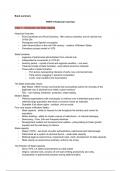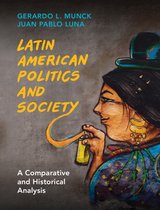Book summary
PART I/ Historical overview
Chap 1 – Introduction and State capacity
Historical Overview
- Post-Columbian era (Post-Columbus, 16th century onwards), end of colonial rule
1810s-20s
- Portuguese and Spanish occupation
- Latin America Born in the mid-19th century - creation of Modern States
- Formation process ended in 1875
State formation
- Legacies of patrimonial adminstration from colonial rule
- Independence movements in 1810-25
- Anarchy period – myriad of local and regional caudillos – civil wars
- Trade-led model of state formation, unity behind economic interests
- Three paths of state formation
- Port actors representing interests of ports, key commercial hubs
- Party actors engaging in electoral competition
- Lords, rural caudillos and hacendados
The State (rationalist views)
- Max Weber (1949) “human community that successfully claims the monoply of the
legitimate use of physical force within a given territory”
- Tilly – war-making, extraction, protection, state-making
Modern States
- Political organisations with monolopoly of violence over a delimited space with a
relatively large population that shres a common sense as nationals
- Guarabtir if all citizen rights – political, civil an social.
Four core issues of Modern States:
- State capacity - ability to impose its rule thoughout the territory and control its
population
- Nation buliding - ability to create a sense of nationhood - of cultural belonging
- Democracy - Free, Fair and Frequent elections
- Development models and socioeconomic welfare - policymaking to foster growth,
equality and the well-being of citizens
State capacity
- Weber (1978) – two kinds of public adminstration: patrimonial and rational-legal
- Patrimonial as a system of personal favors – weak state capacity
- Rational-legal as autonomous, impersonal rules, merit, development of state capacity
- State capcity as autonomous judiciary, enforce rule of law
The Problem of State Capacity
- Since 1875, LA states characterised as weak states
- Origins: colonial roots, process of civil wars limiting productivity and unity,
incorporation of patrimonial practices during state formation
, - Persistense of weak states due to new dictatorships, clientelism, because
patrimonialism breeds patrimonialism
Chap 2 – Nation building, Race and Ethnicity
The Nation
- Nation Building, Race and Ethnicity
- Before the Modern States
- Elite Vision of the Nation (1880-1930)
- The National-Popular Vision (1930-1980)
- Plural Vision of the Nation (1980-2010s)
Chap 3 – Political Regimes and Democracy
Democracy – five criteria
- Free, Fair and Frequent elections
- Right to vote for all adult citizens
- Right to organise parties and run for election
- Elections devoid of fraud and threats
- Freedom of expression, association, assembly, and access to information
Exists partial democracies and authoritarian regimes in Latin America as well
Oligrachy and Authoritarian Regimes (1880-1930)
- Rule of the few
- Usually, families that control plants, mines, and banks and hold strong economic
power
- Special social status and potential access to crucial political power
Types of oligarchies
- Constitutional oligarchies – considerable respect for constitutional rule – varied on
openness to participation and competition.
- Civilian authoritarianism – use of force and electoral fraud – constitutions not binding
- Personalist dictatorships – military background, caudillos – small number of voters
- Puppet regimes – US interventionism – Monroe doctrine – Banana Republic
- Partial democracies – women not able to vote
Transition to Mass Politics and Regime Instability (1930-1980)
- Middle-class, working-class, peasantry and women entering politics
- Authoritarianism due to oligarchic resistance and defeat – Personalistic forms of
authoritarianism persisted in Central America – also due to more US intervention
- Paths to partial democracy – intra-elite political competition – or change from below
with mobilisation of lower classes
- Rights of women and attainment of full democracy – same process of mass politics –
push from below fueled by feminist movements – not consistent at the region’s scale
- Populism and Military coups in 40s-60s – backlash when strong populist movements
(Brazil, Argentina, Bolivia, etc.) – personalistic leaders gaining votes among rural
workers and peasants – the tension between classes – democracy unsustainable
- Cuba case study
- Balance sheet and data pages 108-113
New Democratic Age (1980-2010s)
, - South America first – replacement/death of military leaders in 1980s – installation of
democratically elected presidents
- Central America second – free and fair elections bringing civil wars to an end –
regional peace in 1987 – Mexico joins and completes the wave in 2000
- Why did LA democratise? – role of the left in advocating and campaigning for
democracy – revolutions and civil wars led to radical views and change – economic
globalisation – change of foreign policy from the US with end of the Cold War – role
of critical actors
Chap 4 – Developments Models and Socioeconomic Welfare
Need for economic, as well as social indicators for welfare (life expactancy, poverty rates,
economic inequality)
- Social policies, education, healthcare, pension and retirement
Economic policy instruments
- Fiscal policy – decisions about taxes, state expanditures, ressource allocation
- Monterary policy – decision on monetary supply and interest rates
- Trade policy – free trade to highly protectionist
Distinguished based on treatment of the market, the role of the state in the economy, the
allowance and support of private entrepeunership
Agro-Export Model (1880-1930)
- European and US demand for raw materials – colonies in the Americas broought into
the worls as producers of primary goods
- Largely a model of economic growth, little attention to social policy (exception of a
few countries page 133)
- View that countries should focus on their natural competitive advantages –
international division of labour – no central bank, little monetary and fiscal policy –
gold standard
- Economic liberalism but not political liberalism – protected property rights of wealthy
– plantation economies (coffee, sugar, cotton, tobacco) withlabour conditions almost
similar to slavery – mining economies (silver, gold, tin, etc.) usually in foreign hands,
indigenous people as labour force
- Moderate but unequal progress in socio-economic welfare
- Great depression of 1929, big impact – showed the weakness of the model;
dependence on events outside the control of governments in the region
Import-Substitution Industrialization Model (1930-1980)
- Internal adjustements and homegrown model – political turmoil leading to
mobilisation of masses in political process – middle/working-classes at the center of
new model because largely based on industrialisation – happened in 10 years, later
in Central America
- Keynesian economics – need for active promotion of industry by the state
- Economic policy – new role to the state – industrialisatioon through fiscal and
investment-seeking policies – subsidies to businesses – monetary policy offering
more favorable exchange rates for industries – trade policy, high tarrifs on domestic
production





